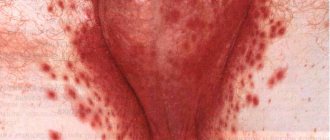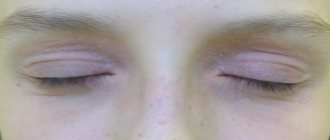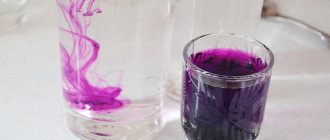What is itchy skin like?
Itching of the skin can be of various types:
- Physiological and pathological itching. In the first case, the skin may itch due to some mechanical or chemical irritants, as well as insect bites. Pathological itching is a sign of a skin disease or other pathological condition, for example, neurological disorders or hormonal imbalance;
- Localized and generalized itching. Itching can be localized in a specific place, for example, under the hair on the head, in the genital area or anus, etc. As a rule, the symptom is paroxysmal in nature, often combined with other pathological manifestations of a particular disease. We are talking about generalized itching when literally the whole body itches. Often the symptom is associated with an allergic reaction or dry skin caused by dysfunction of the sebaceous glands;
- Constant and paroxysmal itching. With constant itching, the symptom persists throughout the day, its intensity may increase at a specific time of day, often in the evening. Paroxysmal itching appears independently or under the influence of certain irritating factors.
Causes of peeling skin
People with dry skin types are more likely to experience problems with flaking skin on their face. Among the common causes of skin peeling, dermatologists and cosmetologists identify:
- Insufficient moisture intake in the form of clean drinking water;
- Climatic conditions of residence (frequent frosts or aridity);
- Incorrect approach to the level of skin care (moisturizing, washing);
- Selecting cosmetics that do not suit your skin or using alcohol-containing products;
- Allergic reaction of the body to external factors;
- Problems associated with stomach diseases, eczema;
- Failure in the hormonal system;
- Mechanical damage (scratches or cuts).
·
Elimination of the consequences of the above factors is possible only with the use of specialized creams or vitamin complexes.
When to see a doctor
You should consult a dermatovenerologist if skin itching and peeling do not go away for a long time (more than two weeks), contribute to sleep disturbances and decreased performance during the day, spread throughout the body, and are combined with other pathological symptoms. These symptoms in combination with an inflammatory or infectious process require urgent contact with a specialist.
Itchy skin, as well as flaking of the skin, can indicate a serious illness, the absence of treatment of which will lead to serious complications. Experienced doctors at the SANMEDEXPERT clinic will conduct a comprehensive diagnosis and prescribe adequate therapy for the identified pathology in order to eliminate unpleasant symptoms and their cause.
Seborrheic dermatitis. Causes
The main causes of this disease are:
1) genetic predisposition;
2) metabolic processes;
3) influence of the external environment.
In 1874, the French microbiologist L. Malassez first hypothesized that the causative agent of seborrheic dermatitis is the yeast-like lipophilic fungi Pityrosporum, which later received its name in honor of this scientist. Fungi of this species are concentrated in the middle and superficial parts of the stratum corneum, inside and between the horny scales, as well as in the hair follicles.
Until now, both names of the causative agents of the disease can be found in the literature: Pityrosporum and Malassezia. Currently, the role of the pathogen Pityrosporum in the pathogenesis of seborrheic dermatitis of the scalp and dandruff has been confirmed by numerous clinical and laboratory studies.
These yeast-like lipophilic fungi are a permanent component of the healthy skin microflora in more than 90% of the population. Fungi concentrate around the sebaceous glands and use their secretions for growth and development. Pityrosporumovale (P. ovale) or according to another classification Malassezia furfur is more often found on the scalp, and Pityrosporumorbiculare on the skin of the trunk.
What diseases cause itching and flaking of the skin?
There are quite a few diseases accompanied by itching and peeling of the skin of varying degrees of intensity and prevalence:
- allergies to food, medications;
- contact dermatitis;
- seborrhea;
- psoriasis;
- eczema;
- fungal skin diseases;
- disruption of the sebaceous glands;
- infectious diseases;
- diabetes;
- hormonal disorders;
- thyroid diseases;
- blood diseases;
- parasitic diseases (scabies, demodicosis, etc.).
Causes of chapping facial skin
There can be several reasons for chapping of facial skin. The main ones:
- Dehydration of the dermis. The skin can peel off due to the fact that a person spends a large amount of time in rooms with excessively dry air (where radiators and split systems operate). Peeling also occurs when you ignore the complete cleansing and moisturizing of any type of dermis, even oily ones. In 20% of people, the epidermis is predisposed to dehydration from birth due to a reduced supply of moisture and glycerol substances from the deep layers of the skin to the surface. Dehydration often occurs due to a deficiency of protein synthesis, a lack of so-called fillagrin.
- Poor quality care for combination and oily dermis. If you have combination skin, dry areas on the cheekbones and corners of the lips are located next to the oily T-zone, and they need to be taken care of differently. Lubricating with greasy cream is not a good idea.
- Thinned, hypersensitive skin. Usually observed in people suffering from allergic reactions. Experienced allergy sufferers know which cream will protect their skin. However, closer to 50 years, the dermis becomes drier and more capricious, as the amount of hormones decreases. And if there is no full hydration, the fabric easily loses moisture, becomes dull, peeling and signs of aging appear.
- Freezing. Dry, cold climate conditions provoke moisture loss in the epidermis, and severe frosts can negatively affect the hydrolipid protection of the skin.
- "Re-cleaning". If you cleanse your face with soap, even the oiliest and densest skin will peel off. Therefore, one of the basic rules of care is not to wash your face until it squeaks and use a special toner after washing. This will preserve the pH of the dermis and the integrity of the hydrolipidic barrier that retains water.
- Frequent exfoliation. Exfoliation is an important step in skincare. However, we are talking about dead cells of the stratum corneum. If you peel more often than the instructions on the product packaging recommend, this will destroy the stratum corneum, and the skin will peel and become chapped. Homemade scrubs are considered more gentle than professional scrubs.
- Hypovitaminosis. If the skin on your face becomes chapped or becomes dry, this may indicate a vitamin deficiency. You can find out which substance is insufficient by taking a blood test. Vitamins A, B, C, D, E, F are recommended to be taken internally, as well as applied externally (as part of anti-chapping products for the face).
- Dry decorative cosmetics. Almost any make-up can cause peeling - contact dermatitis. But the problem with dry cosmetics (even useful ones based on minerals) is that they take away moisture. Therefore, if the dermis is excessively dry and prone to peeling, cosmetics should be applied only after complete hydration.
- Allergic reactions and other diseases. Any allergy, from skin reactions (dermatitis) to runny nose and asthma, can occur in both children and adults. When the cause is not identified, it is important to consult a specialist. In addition to an allergic reaction, the skin may peel and become chapped due to certain diseases of the epidermis, or be a manifestation of internal problems in the body.
Whatever the cause of skin chapping, it can be prevented, the main thing is to follow the recommendations of cosmetologists.
Why moisturize your facial skin and how to do it correctly
The need for moisture saturation is due to constant exposure to the external environment. In summer it is the sun's rays, in winter it is cold wind and frost. Not only the face, but also the hands suffer, but they can be protected by hiding them under clothes, and the face is always open to the winds, direct sunlight, and dust flying into it.
That is why proper care aimed at intensive hydration is vital. For this, it is best to use proven products - based on natural ingredients that do not cause allergies.
We must not forget about the basic rules for saturating the epidermis with moisture:
- The products you use should be selected according to the needs of your skin type.
- Every day it is necessary to cleanse the face - light foams, tonics and emulsions are ideal for this.
- Apply a special cream morning and evening - I recommend using products based on natural extracts with the addition of hyaluronic acid and vitamins.
- Once or twice a week, masks based on essential oils are useful, restoring the protective functions of cells, promoting intensive nutrition and regeneration.
- How and with what can you moisturize your facial skin from the inside? Drink at least 1.5 liters of water per day. This will help you replenish fluid reserves in the body and eliminate the unpleasant feeling of tightness and dryness.
Don't forget about proper seasonal care:
- From the sun - use products with SPF that minimize the negative effects of ultraviolet radiation.
- For frost protection, creams that form a protective film and intensely nourish throughout the day are ideal.
Do you need to moisturize oily skin and how to do it?
You cannot do without products that replenish the moisture deficiency in cells, because water is lost during cleansing. If you skip the “feeding” stage, you will feel dryness, tightness, and discomfort. To avoid discomfort, apply special creams and light lotions every day. You can buy a special gel - it is absorbed much faster. You should not use oil-based cosmetics - they are ideal only for dry and dehydrated skin.
In this article, I told you about ways to combat one of the most common problems - lack of moisture. It can be solved simply - just proper care, a balanced diet and restoration of a normal drinking regime are enough. If you want the discomfort to go away, use liposomal cosmetics containing natural ingredients. They are hypoallergenic, easy to apply, quickly help restore protective properties, promote regeneration and restore a healthy glow. Now you know how and what is the best way to moisturize your facial skin at home - light creams, gels, tonics and masks from a special series.
| Problem | Solution | Means |
| Dryness | Hyaluronic acid saturates cells with life-giving moisture. | Quick view 75 mlMoisturizing cream with peach seed oil920 ₽ Add to cart Checkout |
| Peeling | Aloe and ginseng extracts soothe and remove flaking. | Quick view 50 ml |
How to moisturize facial skin with folk remedies
You can use the following recipes
- Cucumber mask
For it we need the pulp of one cucumber, mixed with heavy cream and rose essential oil. The resulting composition is applied to a previously cleansed face for 10-15 minutes, then thoroughly washed off with warm water.
- Herbal cocktail
Made from chamomile and mint (2 tbsp each). Herbs are poured with boiling milk. The resulting cocktail should cool. Afterwards it is filtered and applied with a cotton pad for 30 minutes, then washed off.
- Vitamin E cream
For it we need a tablespoon of tocopherol mixed with jojoba or patchouli oil. You will also need beeswax, previously ground on a grater. All ingredients are heated in a water bath until thickened. After this, add aloe juice (1 tbsp) and rose oil (4-5 drops) to the mixture. The components are thoroughly mixed. This home remedy should be stored in the refrigerator in a glass jar.
Here's what you can do to moisturize your skin instead of professional cream. However, such recipes can not help in all cases. They often lead to allergic reactions and cause deterioration of the epidermis. This occurs due to improper storage, the use of active ingredients in the wrong dosage, and failure to comply with the conditions for preparing masks, lotions, cocktails, and tonics. I advise you not to take risks and try professional products developed by leading cosmetologists and dermatologists - they also contain natural extracts and oils, but in this case the risk of allergies is minimal, and the benefits are obvious.
Clinical researches
The effectiveness, safety and tolerability of La-Cri products have been clinically proven. The products are recommended by the Union of Pediatricians of Russia. During clinical studies, specialists were able to record excellent results. It has been empirically proven that La Cree emulsion moisturizes and nourishes the skin, relieves itching and irritation.
Sources:
- Chapman M. Shane, Habiff Thomas P., Zug Catherine A., Dinoulos James G. H., Campbell James L., Dermatology. Handbook of differential diagnosis, MEDpress-inform, 2014.
- Sukolin Gennady Ivanovich, Illustrated clinical dermatology. Brief alphabetical reference book, Lux Print publishing house, 2010.
- Sukolin Gennady Ivanovich, Clinical dermatology. A short guide to the diagnosis and treatment of dermatoses, Notabene, 2017.
Recommendations for caring for flaky skin
Before resorting to the use of various moisturizing creams, in order to completely eliminate the problem of dryness and flaking of the dermis, it is recommended to adjust your diet.
Perhaps the skin does not receive enough nutrients in the form of vitamins and macroelements, and not enough water is consumed. There are several essential recommendations to help your skin look healthy and get rid of desquamation. To do this you need:
- Maintain water balance. Drink 1.5-2 liters of water daily;
- Reduce consumption of salt and unhealthy foods;
- Give up bad habits such as smoking and alcohol;
- In summer, use UV protective and moisturizing creams, and in winter - nourishing creams;
- Ventilate and humidify the room in which you are staying for a long time;
- Do not frequently visit saunas and solariums;
- Wash with moisturizing gels and foams;
- Use only high-quality decorative cosmetics.
The following remedies effectively help eliminate dryness and flaking:
- Creams and ointments with lanolin. They create a protective barrier in the form of a film, thanks to a fatty base. They are used once every two to three days. The best option is “baby cream”;
- “Sudocrem” is also one of the inexpensive and good products that will moisturize the face in a matter of minutes, eliminate irritation and desquamation of the epithelium;
- Sea buckthorn oil masks. They can be done once a week or in an emergency. It is a soothing and wound healing agent. The oil is perfectly absorbed into the dermis and quickly relieves dryness and flaking;
- Honey diluted in warm water can be used as a healing mask. It will not only help cope with peeling, but also supply the dermis with nutrients;
- Any nourishing creams at night. Night care is very important for dry skin.
In order for creams to help effectively, they are selected based on the identified cause of peeling. More often they turn to creams with the following components:
- Panthenol (provitamin B5) is a wound-healing regenerative agent;
- Hydrocortisone is an antibacterial agent that belongs to the group of glucocorticosteroids. Used for dermatological diseases;
- B vitamins. Prescribed for severe peeling caused by temperature changes;
- Hyaluronic acid restores and maintains water balance at the cellular level;
- Natural essential and vegetable oils nourish and vitaminize the skin;
- Extracts of medicinal plants, berries and fruits also soothe, relieve inflammation, moisturize and nourish the skin.











